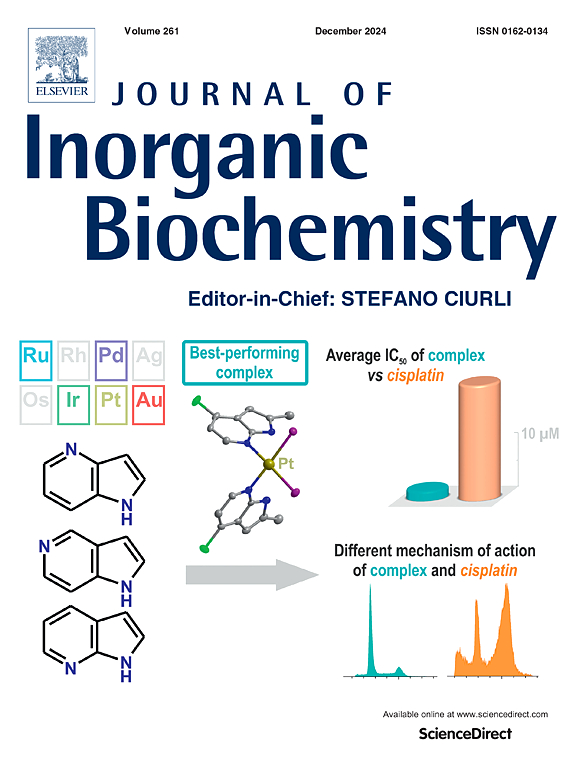由2-(吡啶-2-酰基)- 1h -苯并[d]咪唑(bimpy)和2,2 ' -联吡啶(bpy)衍生的镧系元素(III)配位配合物:光谱分析和细胞毒性评价
IF 3.2
2区 化学
Q2 BIOCHEMISTRY & MOLECULAR BIOLOGY
引用次数: 0
摘要
由三价镧系元素(La, Nd, Sm, Eu, Gd, Tb, Dy)和双齿配体2,2′-联吡啶(bpy)和2-(吡啶-2-酰基)- 1h -苯并咪唑(bimpy)合成了七种新型配位配合物(1-7)。一系列的分析和光谱技术,包括高分辨率质谱法,明确地表征了所有的复合物。利用配体混合物制备具有抗癌活性的配位配合物已显示出良好的效果。因此,我们进行了进一步的实验来评估非转化细胞(NIH/3 T3和J774A.1)和转化细胞(HeLa, Caco-2和MCF-7)的细胞毒活性,并在人红细胞中进行了红细胞溶解实验。结果显示对所研究的细胞系有中等但选择性的细胞毒性。通过PBE0/def2-SVP的计算研究,阐明了配位数、几何形状和结构组织与实验数据一致。本文章由计算机程序翻译,如有差异,请以英文原文为准。
![Coordination complexes of lanthanide(III) derived from 2-(pyridin-2-yl)-1H-benzo[d]imidazole (bimpy) and 2,2′-bipyridine (bpy): Spectroscopic analysis and cytotoxic evaluation](https://img.booksci.cn/booksciimg/2025-7/102305252781782844057.jpg)
Coordination complexes of lanthanide(III) derived from 2-(pyridin-2-yl)-1H-benzo[d]imidazole (bimpy) and 2,2′-bipyridine (bpy): Spectroscopic analysis and cytotoxic evaluation
Seven novel coordination complexes (1–7) derived from trivalent lanthanides (La, Nd, Sm, Eu, Gd, Tb, Dy) and bidentate ligands 2,2′-bipyridine (bpy) and 2-(pyridin-2-yl)-1H-benzo[d]imidazole (bimpy) were synthesised. A series of analytical and spectroscopic techniques, including high-resolution mass spectrometry, unambiguously characterised all complexes. Using ligand mixtures to obtain coordination complexes with anticancer activity has shown promising results. Therefore, additional experiments were performed to evaluate the cytotoxic activity in non-transformed cells (NIH/3 T3 and J774A.1) and transformed cells (HeLa, Caco-2 and MCF-7), as well as erythrocyte lysis experiments in human red blood cells. The results revealed moderate but selective cytotoxicity against the studied cell lines. Additional PBE0/def2-SVP computational studies were carried out to elucidate the coordination number, geometry and structural organisation in agreement with the experimental data.
求助全文
通过发布文献求助,成功后即可免费获取论文全文。
去求助
来源期刊

Journal of Inorganic Biochemistry
生物-生化与分子生物学
CiteScore
7.00
自引率
10.30%
发文量
336
审稿时长
41 days
期刊介绍:
The Journal of Inorganic Biochemistry is an established international forum for research in all aspects of Biological Inorganic Chemistry. Original papers of a high scientific level are published in the form of Articles (full length papers), Short Communications, Focused Reviews and Bioinorganic Methods. Topics include: the chemistry, structure and function of metalloenzymes; the interaction of inorganic ions and molecules with proteins and nucleic acids; the synthesis and properties of coordination complexes of biological interest including both structural and functional model systems; the function of metal- containing systems in the regulation of gene expression; the role of metals in medicine; the application of spectroscopic methods to determine the structure of metallobiomolecules; the preparation and characterization of metal-based biomaterials; and related systems. The emphasis of the Journal is on the structure and mechanism of action of metallobiomolecules.
 求助内容:
求助内容: 应助结果提醒方式:
应助结果提醒方式:


